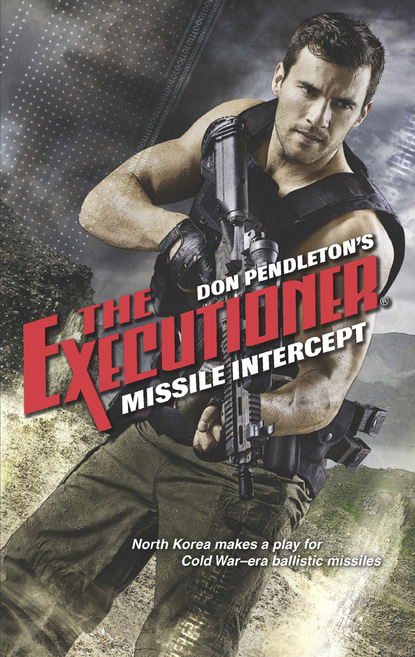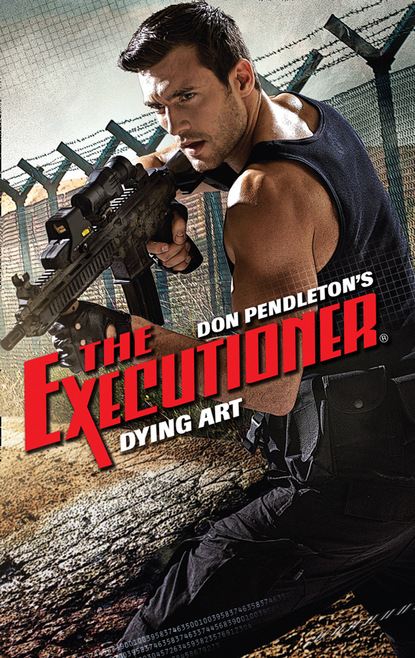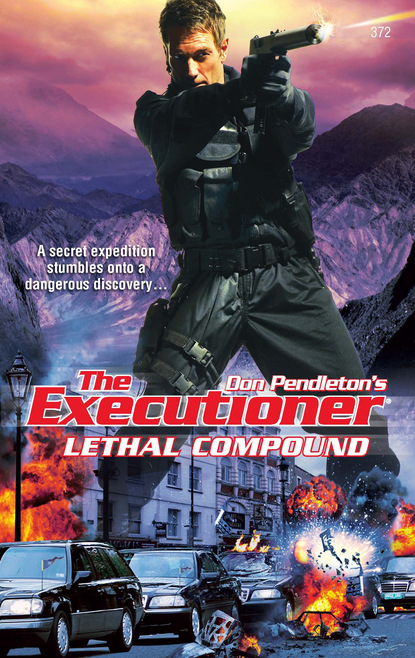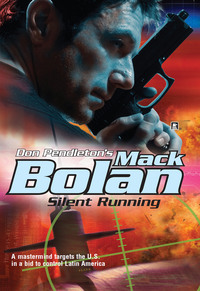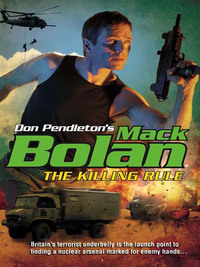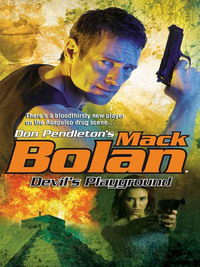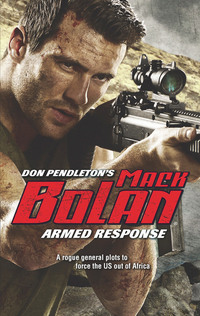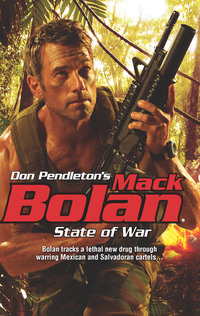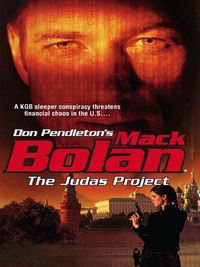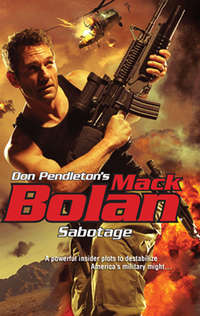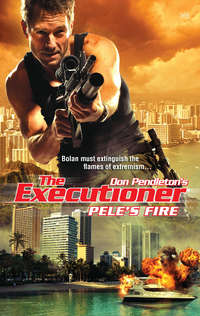
Полная версия
Orange Alert
Bolan removed the goggles and returned them to their pouch. The men waiting for him obviously knew that Oxford was wearing a transmitter that would lead someone to his remains. Did they also know that he had been a CIA plant? And, if they did, what were their intentions now for the man who came to retrieve him?
Regardless of what they had been planning, the Executioner thought they were about to get more than they’d bargained for.
He rose into a crouch and set off, as silent as an owl swooping from above to snatch unsuspecting prey. When he finally got to a point about twenty yards behind them and they became visible in the dim light, he lowered himself again to one knee and took note of how the three were set up. He figured they would be facing his objective. He switched the earpiece back on.
The beat was coming in as an almost steady tone, and the note had changed, indicating Bolan was slightly off center. Before turning the signal off, he mentally extrapolated the sound with his position and that of the ambush, arriving at a spot about fifty yards from where he thought Oxford’s body would be buried.
He withdrew a powerful penlight from his front shirt pocket and rotated the lens to produce a beam. Sliding the Desert Eagle from its holster, he stood and took a step forward.
“Everyone freeze!” he shouted in a voice full of authority as he held it out at a full arm’s length to the left of his body.
The three men, suddenly illuminated, simultaneously made the wrong decision. As the two men flanking the third threw themselves to the ground, the man in the middle turned and fired a pistol, the round snapping the air directly beneath Bolan’s penlight, which he switched off while lunging to his right. In midair, he squeezed the Desert Eagle’s trigger once, and the throaty roar of the weapon delivered instant death to his attacker as the heavy round slammed through the man’s chest, exiting through his back in a messy hole the size of a heavyweight’s fist.
Bolan rolled quickly as bullets from the other two gunmen sliced the air where he had been a split second earlier. Using one of the muzzle-flashes for a target, Bolan fired two shots so close together that they echoed across the moors as a single retort. He immediately heard the heavy thump of a body being hammered into hard earth, and all was still.
Continuing his roll to the right, Bolan strained his ears for the sound of his enemy’s breathing. In the sudden silence, he could hear it—raspy and quick. The man was off to his left, about ten yards away, and apparently still standing upright.
Bolan considered taking him alive in order to gain some intel about the communiqué. Before he could initiate his next move, however, panic apparently got the better of his adversary, who abruptly let loose with a barrage of automatic pistol fire aimed a full four feet above Bolan. With the shooter illuminated by his series of quick muzzle-blasts, Bolan zeroed in from his prone position and fired once, drilling a hole through the man’s gut. The force of the Eagle’s .44-caliber punch threw the hardman four feet and he crumpled into a lifeless heap, oozing intestines that shimmered and shone black in the intermittent moonlight.
Like most firefights, this one had been quick and violent.
The acrid smell of cordite hung heavy in the air, mingling with the fresh stink of death that filled Bolan’s nostrils. He remained in his prone position, listening intently for any sound of life. After a good thirty seconds, he rose to his full height. Holding the penlight out to his left again, he switched it on.
All three men were dead.
Bolan quickly scanned the area, anxious to complete his mission. There was no vehicle, which meant that these men had either left their means of transportation somewhere and walked to the site as Bolan had, or they had been dropped off by other team members who were still very much alive.
In the beam of his penlight, tire tracks were visible in the dirt, confirming Bolan’s worst-case hunch. He rushed forward to check the bodies, intent on removing any identification they might be carrying. As he patted down the first corpse, he noticed the gleam of a silver chain around the man’s neck. With the same motion he had used more often than he wanted to remember when pulling the dog tags from a fallen comrade, Bolan snapped the chain free and stuffed it into his pants pocket. He continued checking the body for identification, and, finding none, moved on to the other two with the same results. None carried ID of any kind, but all three had worn a medal around their necks.
Turning his back to the bodies, Bolan switched his earpiece receiver back on. The signal was strong and steady, and as he sprinted to the spot he had selected before the firefight broke out, the tone became solid. In the moonlight, Bolan could see the dim outline that had the correct dimensions for a shallow grave. When he stood over it, the earpiece told him he had found his mark.
He pulled the foot-long combat knife from its sheath and plunged it into the soft earth. Just as the hilt touched ground, the tip of the blade made contact. In the distance, Bolan could hear a new sound—the steady drone of a vehicle that sounded big. He didn’t know for sure how distant it was, but the way sound traveled over the moors, he thought he had at least five minutes before it would reach him. He began to claw at the grave, moving the loose soil to both sides. In less than a minute, he reached the body. Holding the penlight with his teeth, he saw that luck was with him—the end he had chosen to clear exposed Oxford’s head, the upper portion above the agent’s eyebrows mangled and singed around the edges by the point-blank shot that had taken his life. The bottom half of his face was smeared with dirt and, after three days in the grave, swollen beyond recognition.
Leaning forward, Bolan grabbed the corpse’s head and brushed the dirt away from its mouth. Placing the point of his combat knife at a spot directly beneath Oxford’s earlobe, he opened the agent’s cheek with a quick forward slice, revealing teeth that shone like pearls in the penlight’s beam. In the back of the dead man’s throat, insects scurried to escape the sudden illumination.
Bolan pushed the flap of bloodless skin away so he could insert the tip of his blade under the last molar. In the back of his mind, he was aware that the vehicle was drawing closer, coming slowly due to the winding roads, but approaching, nevertheless, at a steady pace. As he twisted the knife’s handle and the dead agent’s tooth popped free, Bolan wondered what had prompted its approach. Whether it was responding to the sound of gunfire traveling a great distance through the clear still night, or a missed call-in from the men waiting in ambush, the result was the same—there was no time to retrieve Oxford’s remains. But Bolan had the most important thing he had come for and he could mark the body’s location for a future pickup by placing his earpiece with the corpse.
He dropped the extracted molar into the same pocket containing the chains he had taken from his would-be ambushers, shoved his earpiece down the front of Oxford’s blood-enrusted sweater and hurriedly pushed the dirt back over the body. Just as he was finishing, he caught the glimpse of approaching headlights winding their way down the side of the shallow bowl-shaped valley less than a quarter of a mile away.
After smoothing the earth back over the shallow grave, he ran at full speed for a stand of trees and thick bushes about a hundred yards away. He had progressed less than ten feet into the woods when an SUV burst out of the adjacent hillside pasture onto the flat land of the moors, and the night was suddenly filled with the eardrum-splitting sounds of AK-47s chattering in full-automatic mode.
The air surrounding Bolan became a deadly beehive of activity as bullets whizzed by with the distinctive snaps of 7.62 mm bullets. He dived to the ground, scrambling for cover.
2
The furious fusillade ended abruptly, and Bolan heard the distinctive metallic rattling of empty magazines being ejected, followed by the slide and click of new ones being rammed home. In the sudden silence, rendered more profound by its extreme contrast to the deafening uproar from the AK-47s that still echoed in his brain, a wide beam of blinding light painted the trees and thick bushes with broad strokes, sweeping back and forth through the stretch of woods like a prison spotlight.
From his prone position in a tiny depression behind a stout hickory, Bolan flexed his legs in preparation for his departure. He peered through the lush foliage, inches above ground level, to where the SUV stood like an alien being, its modern technology seeming anachronistic against the barren landscape.
Accompanied by the racing sound of its powerful engine, the vehicle spun in a cloud of dust, casting its lights onto the ambush site littered with three bodies. As Bolan moved in a crouch through the woods to put distance between himself and the new arrivals, he heard the opening of a door followed by loud cursing in a thick brogue. A quick burst of automatic fire sliced through the trees at least fifty yards to his left. It was an obvious gesture of anger and frustration, and it reinforced Bolan’s earlier opinion that his opponents were deficient in both their training and discipline. This lack of professionalism would be a factor he’d leverage to his advantage when they finally clashed again, which was bound to happen sooner or later.
The SUV wasn’t able to follow him through the trees, but Bolan knew that the stand would eventually end and he’d find himself at the edge of a sheep pasture somewhere with no available cover. If the men in the vehicle were locals, they’d know the place where the woods ended, and that’s where they’d be waiting.
Crouching behind a thick tree, Bolan checked his watch for the time: 2:30 a.m. The summer equinox had occurred a scant two weeks earlier, which meant that, at this time of year, sunrise came quickly to the regions up around the fifty-fifth parallel. The area was at about the same latitude as Glasgow, where dawn would break around four-thirty. Bolan didn’t know how long it would take him to reach the tracks where he’d heard the trains rumbling, but he thought it would be to his advantage to get there before daybreak.
As he made his way through the woods, Bolan recalled the information contained in the second communiqué that had been delivered to the local CIA office and forwarded to the President. The Apprentices, a rogue splinter group claiming to be sponsored by the Orange Order, was demanding immediate disarmament of the IRA, and international recognition for the legitimacy of home rule in Belfast. Once and for all, they wanted the world—and especially the United States—to endorse the existence of two nations in Ireland and to formally declare that there was no chance the two would ever be united. Once and for all, they wanted to end the Irish conflict, and they were prepared to use terrorism to force the result.
They further said they were about to release a list of prominent Catholics, whose assassinations were being scheduled to occur until the process of IRA disarmament was complete. And, finally, they were threatening the United States with a domestic terrorist attack if their demands were not met by the end of July. That gave the CIA less than a month to find and destroy the people behind the plot.
It was an insane scenario, made viable by the global terrorism that had spread like a runaway cancer since the fateful assault on New York’s World Trade Center.
As Bolan pushed forward toward the sounds of distant trains, one thing was clear in his mind—any mission that prevented another terrorist attack on the United States was worth his involvement.
The Executioner had been deployed, and he was prepared to give as good as he got.
BOLAN ARRIVED AT THE TRAIN tracks as the first suggestions of predawn light were touching the eastern sky. He estimated he was eight or nine miles away from where he had left his car, but, luckily, the tracks were configured north to south. As long as he jumped a train going the right way, it would bring him closer to his transportation.
He paused at the edge of the woods and, while remaining concealed by the mulberry bushes that populated a narrow gully extending from the trees to the tracks, he reached into the pouch containing his night-vision goggles. With the coming dawn, ambient light was greatly increased and, with it, came maximum visibility.
The SUV that had attacked him at the ambush site was nowhere to be seen and a quick glance around the area explained why. This section of track was as inaccessible to wheeled vehicles as the woods had been. A rushing mountain stream cut through the hilly area to the north and rough outcroppings littered the terrain on the other side of the tracks for as far as Bolan could see.
He heard the sound of a slow freight train coming his way, the steady clack of wheels on the rails indicating a speed that could probably be jumped. Placing the goggles back into their pouch, he headed down the gully to a concealed spot close to the tracks.
The train came around a curve and into sight, going faster than Bolan had originally judged. He remained motionless as the double locomotives reached his position and sailed past at about thirty miles per hour—a little too quick for him to attempt a clean jump.
Remaining hidden under the cover of bushes that grew along the tracks to heights of more than six feet, Bolan opened the pouch on his web belt, which held a grappling hook and a length of special cord developed for its strength. Thin and waxy, the lightweight fiber looked like braided strands of dental floss and, although it had a texture so fine a twenty-foot length could be folded to fit into a shirt pocket, it was stronger than the nylon rope used by mountaineers.
Bolan knotted his titanium grappling hook to the cord, and, while judging the feel of the hook’s weight by letting it swing slightly on a few feet of slack, he eyed the passing freight cars for the right opportunity.
More than two dozen boxcars had already passed. A series of double-length flatbeds holding tarp-shrouded cargo came into view. As the cars drew closer, Bolan’s eyes searched for possible catching points on the heavy ropes that were lashed across the gray canvas tarps and fastened to metal cleats running along the outside edge of the flatbeds.
Bolan gave the knot a final tug, stepped out from behind the bush and began to run alongside the train. When the first of the flatbeds with the covered freight passed, he increased his speed while whirling the hook over his head like a rodeo cowboy. As he reached a full sprint, he zeroed in on one of the tarp’s restraining ropes and let it fly. The grappling hook caught at the very top of the tarp on his first attempt, yanking him up and onward as he tightened his hold on the cord. With the muscles in his shoulders and forearms straining, he jumped and pulled with all his strength, his feet clearing the edge of the moving car with inches to spare. Drawing himself forward on the line, he quickly reeled in the slack and freed the hook, putting it back into its pouch on his web belt.
The tracks were level and in good shape, giving the train a smooth, steady ride. Holding on to the slick surface of the canvas tarp, Bolan moved to the front of the flatbed where there was space for him to sit and rest. He reached a clear spot and settled onto the pitted deck with his back resting against the covered cargo as dawn painted the Irish countryside in crisp morning light.
The terrain was changing, morphing from the barren hostility of the moors to pastures that stretched green and fertile under the rising sun. A rust-flaked trestle came into view up ahead, its blistered surface glowing fiery red in the early light. The structure was a remnant from previous years when trains on this run were used for more than simply transporting freight, but its presence made Bolan consider the safety of his position. As he passed under the trestle’s crossbeam, he reasoned that with pastures there would be crossroads, and with the crossroads there would be bridges above the tracks. Unlike the rusting trestle he had just passed under, a bridge could hold an SUV.
Bolan thought his pursuers not only would have known where his escape route from the ambush site would take him, they also would have considered what his options would be once he reached the tracks. As he checked to make sure that both his Desert Eagle and the Beretta were ready for action, he wondered if hopping the train was too obvious.
He calculated he had about fifteen minutes until the tracks began ascending into the mountains along the coast. At that point, he’d get off and walk the rest of the way to his car.
THE SUV’S HIGH PROFILE made it visible from afar. It was sitting on a narrow bridge spanning the tracks, illuminated by the angled rays of the morning sun as if it was on stage. The four men armed with Uzi machine pistols standing in pairs on each side of the vehicle were facing into the sun, putting them at a distinct disadvantage.
Bolan inched to the forward edge of the flatbed and looked around the corner of the cargo loaded onto the car in front of him. Next to the tracks below the SUV, men stood on each side of the passing train, both armed with AK-47s. At the current speed, Bolan estimated he’d be next to them in about three minutes and he’d be exposed for a clean shot from above as well as from both sides.
His eyes darted around the flatbed for a place for him to hide. Even if he got under the tarp, he didn’t know if there would be something he could get behind to afford cover from gunfire, but he certainly couldn’t stay where he was.
Pulling his combat knife from its sheath, he sliced the closest restraining rope. The freed corner of the tarp flapped up, exposing the bottom half of wooden crates stacked so tightly and neatly against one another there wasn’t room for a mouse to crawl between.
As he put the knife away, the Executioner leaned back and looked down, viewing the heavy coupling mechanism linking his car with the one in front. There was a wide space between the clamp and the beginning of his flatbed. With less than a minute and a half remaining before he’d pass under the bridge, Bolan decided the coupler was his only chance for getting past the SUV.
He lowered himself onto the rod between cars, held on tightly to the greasy coupler and slid himself under the flatbed. At first, he thought he’d have to hold his legs up to keep his heels from dragging on the tracks, but once he got under the cargo deck, he discovered there was a beam running across the car about a foot below the flatbed’s underside. Bolan slid his legs into the space and found he could balance himself faceup, mere inches below the flatbed’s deck. And, although he felt pinned in this position, the supporting beam allowed him free use of both hands.
As the train neared the bridge, he wiped his greasy hands on the front of his shirt before drawing his Beretta from its shoulder leather. With his other hand, he pulled the Desert Eagle from his hip holster.
The flapping tarp caught the attention of the men on both sides of the track. Thinking that Bolan was hiding under the canvas, they began spraying the cargo with gunfire, the cracking of 7.62 mm rounds masked by the sound of the train. With their eyes focused on their target, they stitched holes across the tarp in a crisscrossing pattern from corner to corner, never seeing the man suspended in the dark shadows beneath the railroad car.
As he passed between them, Bolan fired with both hands, his weapons spitting death. The rifleman on the right side was hit inches above his belt with three of the Beretta’s 9 mm parabellum rounds. They shoved him backward, his rifle sending a spray of bullets wildly into the air as his finger froze in a death grip on the AK-47’s trigger until the magazine was spent and the bolt clicked onto an open chamber. As he stumbled under weak knees into a sitting position, he dropped his weapon, never knowing the origin of the rounds that were ending his life. With a short low scream that turned quickly into a hard grunt, the gunner fell onto his back while clutching his guts in a futile attempt to stem the flow of blood that surged warm and steaming into his hands.
The man on the left was dispatched by two heavy rounds that roared within a millisecond of each other from the mouth of Bolan’s Desert Eagle. The steel-jacketed rounds caught the guy midchest, tossing him like a rag doll into the brush alongside the tracks where he landed on his back, arms outstretched.
On the bridge above, the men standing next to the SUV searched for the source of gunfire but, before they could locate it, Bolan’s flatbed passed under their position and he became shielded from their weapons by the cargo strapped to the car behind him. Cursing, they scrambled to the other side of the bridge and watched the cars passing underneath. Two of the four opened fire with their Uzis, hosing the flatbeds with a steady stream of 9 mm rounds that sparked and whined as they ricocheted off the metal couplings and tracks.
Once he was beyond their position, Bolan quickly holstered his weapons and pulled himself out from under the railroad car. He peered around the edge of the bullet-riddled canvas in time to see four men dropping from the bridge onto the cargo-laden flatbed three down the line from his. The fixed wooden stocks on their Uzis told Bolan they were carrying older models, but even the earliest versions were formidable killing machines.
The men were obviously planning to work their way forward until they came to Bolan’s position. As he visualized his attackers working as a team, covering one another with a forward wall of lead while advancing up both sides of the cargo on each flatbed, Bolan knew there was a strong possibility they’d successfully reach him.
He scrambled to the other side of his car and peered around the corner. A hail of bullets ripped the canvas directly in front of his face, causing him to pull back out of their line of fire. But in the short seconds before he ducked behind cover, he had seen enough to know his pursuers were employing the exact tactic he suspected. One of them had already begun inching along the outside of their cargo load.
A trestle passed overhead, and Bolan began counting. Switching the fire selector on his Beretta to the 3-round burst mode, he reached around the side of the shredded tarp and pressed the trigger, exposing no more than his hand for a few seconds. The triburst forced the gunners to duck, giving him the seconds he needed to sneak another quick look. The man halfway up the side of the flatbed directly behind Bolan’s had been hit in the upper chest and was holding on for dear life to a rope laced across the cargo. Bolan fired another 3-round burst, and the man’s head exploded in a crimson bloom of brain matter and bone splinters that splashed onto the canvas tarp. As the man’s lifeless body slid to the ground, his legs fell at an angle onto the tracks where they were severed by the train’s heavy steel wheels as cleanly as if by a guillotine.
A return volley made Bolan pull back behind the cargo, but not before he saw the trestle pass over the end of their car. He had counted to thirty-two from the time the trestle passed over his head until he saw it clear the car where his attackers crouched. He lunged to the other side of his car and fired a few bursts down the left side of the train, reloaded, then jumped back to the right side and repeated the action. For the time being, his opponents were remaining behind the cover of their cargo.
Bolan leaped to his full standing position, grabbing a quick look across the top of the tarps. As he had expected, his movement was met with a blizzard of lead that forced him back down, but not before registering the angle at which one of the men was climbing onto the top of the cargo. With the same technique he had used for the assailant trying to rush the side of the flatbed, Bolan fired above the tarps without looking, thereby giving his foes the smallest target possible by only exposing his hand for the few seconds it took to press the Beretta’s trigger. The howls and shrieks of fury immediately reaching his ears told him he had found his mark. Stealing a quick glance over the tarp, he saw his opponent fall from the top of the cargo before the remaining two forced Bolan down with a spray of bullets.




